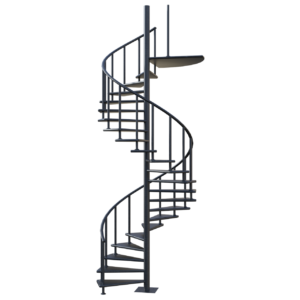Stairs are important constructions. They make it easy to access the upper floors of a house without the need for special equipment. Compared to lifts and escalators, stairs are cheaper to install and maintain. They can be used together with lifts and elevators in busy public buildings to save time. You don’t have to wait for the lift to arrive on your floor; take the stairs and achieve the recommended 30 minutes of daily physical activity while at it.

Importance of stairs
The primary use of stairs is to enable quick and effective access to the upper levels. In the olden days, buildings were only one-storeyed, and there was no need for stairs. But later, as people realized they could construct multi-storeyed buildings to maximize the use of space, stairs became indispensable. Nowadays stairs can be found in almost every storeyed building. There’re even special stairs with ramps and stairlifts to make them more accessible.
Another use of a stair is partitioning large open areas. Stairs can also serve as the structural centerpiece of a home. Moreover, you can get creative and install cupboards below stairs, turning them into convenient storage locations.
Stairs are also used for aesthetic purposes. How many times have you been awe-stricken after arriving at a property and seeing a magnificent carved oak staircase? Even with elevators and lifts around, stairs haven’t lost their charm. Families still utilize different stair design to show class and wealth.
Stairs Glamorize a home.
Stair climbing is good for your health. Indeed, stair climbing has been linked to healthy body weight, good bone density, reduced risk of mortality, and an increase in ‘good’ cholesterol in the blood. Scientists say stair climbing uses about 8 -11 calories per minute; that exceeds the number of calories burned in most moderate level physical exercises.

Stair, stairs, stairway, staircase, stairwell: what’s the difference?
A stair is an individual step in a flight of stairs. Stairs refer to a complete series of steps between two floors. Stairway and staircase refer to the same thing, stairs and their supporting structures, including handrails and landings. A stairwell is a vertical compartment with stairs inside; you can also refer to the walls surrounding stairs as a stairwell.
Types of stairs
Stairs may be spiral, straight, or round. They may also consist of straight pieces joined at angles. Stairs can also be categorized according to the material and design. When it comes to the cost of stairs, the complexity of the design plays a big role.
Straight stairways vs. spiral stairways
Straight stairways consist of stairs connecting two floors without turning along the way. Straight stairs are one of the most popular types of stairs in residential and commercial buildings because they are easy to climb and descend. They are relatively easy to build and don’t require an intermediate supporting structure. They are especially loved by people who prefer minimalist home designs, but they take up a great amount of linear space and offer no privacy.
It is common to see two straight series of stairs connected at various angles resulting in L Shaped stairs, U-shaped stairs, etc., for more visual appeal.
On the contrary, spiral stairs take on a helical arc to offer a wide range of advantages depending on your style and space. They usually boast a compact design with treads radiating around a central column.
Spiral stairs have a small footprint, making it stress-free to fit into any floor design, be it open floor or square footage. Spiral stairs are also very attractive and come with various railing styles for an aesthetic appeal, and there’s no need for extra supporting structures; the landing and center pole do all the work. But spiral stairs are a bit difficult to climb and descend, especially when carrying bulky items. In fact, only one person can navigate spiral stairs at the same time.
Types of spiral stairs
When considering spiral stairs designs, diameter, height, and location, along with aesthetics such as treads style, handrails, and balusters, matter a lot. The height measurement is important for safety concerns. It also determines the number of individual steps. Diameter, on the other hand, simply refers to how wide a stair is. Depending on the diameter, the staircase may or may not fit into your space. Types of spiral stairs designs include:

Metal spiral stairs
Metal spiral stairs can be classic steel or forged iron. Both are appreciated for their traditional elegance. They are flexible designs for fitting into various interior home designs with just slight customization. The design can be all metal, or you can throw in solid wood handrails and treads for a magnificent centerpiece. Some recommended examples are:
All wood spiral stairs
Wood spiral stairs will always be an attractive alternative to metal spiral stairs because they are affordable, easy to maintain, and naturally eye-catching. All wood spiral stairs are usually made from kiln-dried yellow pine, cedar, red oak, tropical hardwoods, etc. They offer the strength of metal stairs while adding warmth and charm to the house. Additionally, wood has a great natural smell.
Powder Coated Aluminium and Galvanized steel
Galvanized steel and powder-coated aluminum are fantastic materials for constructing outdoor spiral stairs. They make durable stairs that can fit into various aesthetics. They are usually finished with weather-proof barriers and custom colors.
That said, many stair manufacturers can customize their stairs based on your budget, needs, and safety fears. Plus, you can always choose to accessorize using various products to make a statement.
Wrapping up
Stairs can be a wonderful addition to a home. Depending on the design, they can be easy to navigate, and they also make a difference in the home’s aesthetics. Stairways operate without electricity or any special equipment; just the flight of stairs, a handrail, landing, and other products are enough for you to access different floors in a property. Besides, stair climbing is helpful health-wise. Stair climbing uses about 10 calories per minute, and in a year, you drop about 6 pounds of weight. How advantageous!